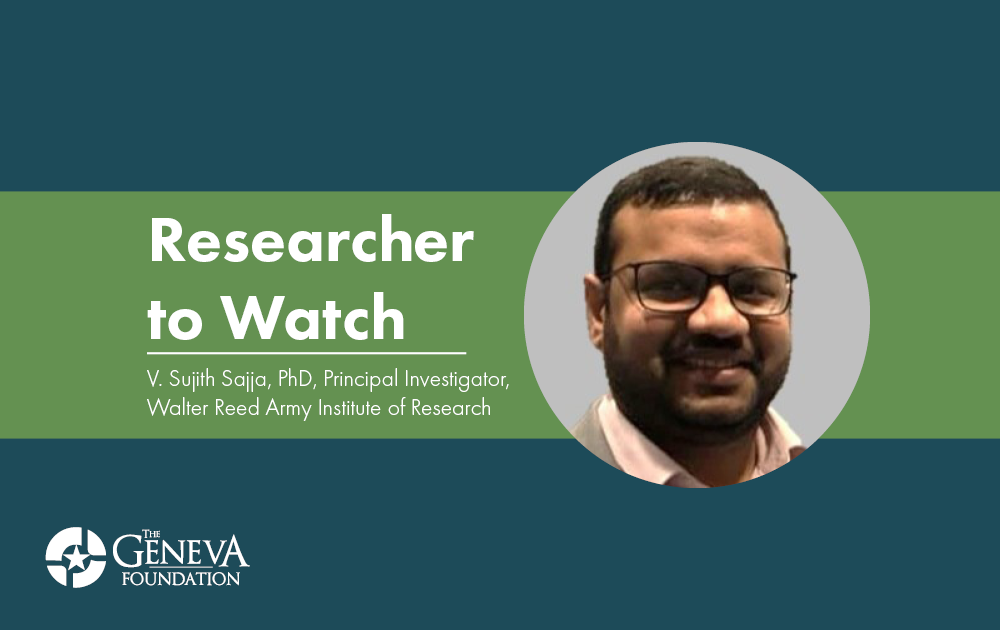30 August 2021
Evaluating the Effectiveness of EOD Bomb Suits as Countermeasures to Blast Trauma
Researcher to Watch: Venkatasivasai Sujith Sajja, PhD
Blast-induced trauma is a major concern for the U.S. military because of the complex injuries that can present after exposure. Understanding the effectiveness of personal protective equipment effectiveness against blast is an important step to prevent these deleterious effects.
Sujith Sajja, PhD, principal investigator at the Center for Military Psychiatry and Neuroscience Research at Walter Reed Army Institute of Research (WRAIR), has spent over the last decade investigating blast effects using state-of-the-art MRI technologies, pre-clinical models, and translational studies to understand and prevent risk against warfighters following blast trauma. He has published over 35 peer-reviewed publications and has been cited over 750 times in research areas such as lung and brain injury, neuroimaging, and biomechanics.
Dr. Sajja, in partnership with research scientists at WRAIR’s Wound Infection Branch at the Center for Infectious Disease Research, is also conducting poly-traumatic effect studies including infection development to help improve the warfighter’s point-of-injury care outcome that can translate from bench to bedside.
In 2020, Dr. Sajja received a $2.8M award from the Medical Technical Enterprise Consortium (MTEC) in response to a solicitation for the “Development of Survivability Criteria and Vital Organ Injury Metrics for Whole Body When Exposed to Extreme Blast.”
The objective of this Geneva-managed research is to develop injury risk metrics to assess the effectiveness of Explosive Ordinance Disposal (EOD) bomb suits as countermeasures to primary blast. In collaboration with Virginia Tech, Dr. Sajja’s research team is using an advanced blast simulator to produce blast pressures in the laboratory. The laboratory studies are conducted in parallel with live-fire testing at Aberdeen Test Center to closely replicate explosive blast detonations in the field. He aims to understand key variables of bomb suits with preclinical studies.
“We will also conduct experiments to identify and understand biomechanical perturbations in conjunction with biological behind the armor,” said Dr. Sajja. “This will allow us to understand injury risk curves for survival and hemorrhage, and inform future efforts concerning bomb suit and other PPE testing to protect our warfighters.”
By establishing the effectiveness of bomb suits, Dr. Sajja’s team hopes to develop scalable parameters that can be readily translatable to benefit even more individuals.
In another Geneva-managed study titled “Lung Injury Etiology, Risk Factors and Morbidity of Single and Repeated Low-Level Overpressure Exposure” funded by Congressionally Directed Medical Research Programs, Dr. Sajja is addressing research gaps that exist with blast overpressure-induced lung injury. He hypothesizes that “cumulative low-level blast exposures yielding no apparent gross injury induce inflammation and fibrosis in alveoli and small airways leading to long-term cardiopulmonary functional deficits.”
For U.S. military service members and veterans, this knowledge gap creates challenges of diagnosis, management, and prognosis that have been under-recognized. In this translational study, Dr. Sajja has partnered with the New Jersey-War Related Illness and Injury Study Center to conduct clinical studies.
“Chronic unexplained cardiopulmonary symptoms of shortness of breath and decreased exercise tolerance have been attributed to burn pit smoke and other airborne hazard exposures while the possible contribution of blast exposure – the signature wound of post-9/11 deployments – has not been thoroughly studied,” said Dr. Sajja. “In addition, there is no information on how sub-threshold blast exposures affect pulmonary function and pathogenesis despite several epidemiological reports showing an association with blast and long-term pulmonary deficits.”
Dr. Sajja’s work is improving lives for military service members and veterans. Geneva is proud to collaborate with Dr. Sajja to advance military medical research in critical areas such as blast-induced vital organ trauma.
Disclaimer: The views expressed do not reflect the official policy of the Department of Defense, the U.S. Army, or the U.S. Government.

"This (research) will allow us to understand injury risk curves for survival and hemorrhage, and inform future efforts concerning bomb suit and other PPE testing to protect our warfighters."
Sujith Sajja, PhD, principal investigator at the Center for Military Psychiatry and Neuroscience Research at Walter Reed Army Institute of Research (WRAIR)
HIGHLIGHTS
- Understanding the effectiveness of personal protective gear such as EOD bomb suits effectiveness against blast is an important step in protecting our warfighters.
- Dr. Sajja received a $2.8M award from MTEC in response to a solicitation for the “Development of Survivability Criteria and Vital Organ Injury Metrics for Whole Body When Exposed to Extreme Blast.”
- By establishing the effectiveness of bomb suits, Dr. Sajja’s team hopes to develop scalable parameters that can be readily translatable to benefit even more individuals.
- In another Geneva-managed study, Dr. Sajja is addressing research gaps that exist with blast overpressure-induced lung injury.


